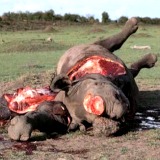Gemsbok: Africa's Desert Survivor with Superpowers
The gemsbok is a remarkable symbol of desert survival, embodying the resilience and adaptability that define Africa's most extreme ecosystems. These large African antelopes belong to the genus Oryx, with the gemsbok specifically identified as Oryx gazella.
Unlike any other desert specialist, gemsboks possess extraordinary physiological and behavioral adaptations that allow them to thrive where few other animals can survive. Their striking appearance, combined with their legendary hardiness, has made them iconic figures in African wildlife and a favorite subject for nature enthusiasts and wildlife photographers worldwide.
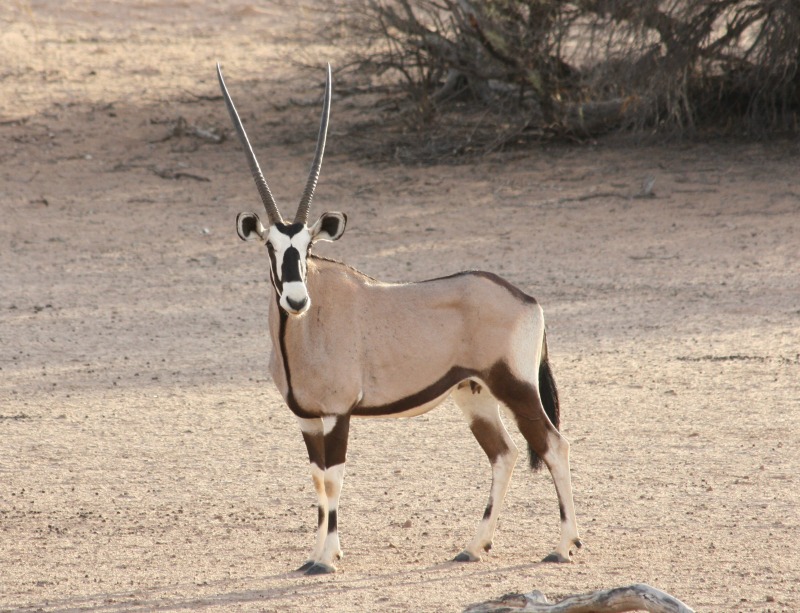 All four legs of gemsbok are black on the top halves and white below the knees
All four legs of gemsbok are black on the top halves and white below the kneesColor is a pale fawn grey.
White on the belly and inside the legs.
There is a black stripe down the spine.
They have a black patch on the top of the rump.
All four legs of this antelope are black on the top halves and white below the knees.
The tail is black with long hairs at the end.
They have distinctive black and white markings on the face, white around the mouth and the nose, black on top of the muzzle.
A black band runs from the front of the ear through they eye.
Habitat and Geographic Distribution
Gemsboks live in arid grasslands and rocky deserts, with the Kalahari-Sandveld representing their primary habitat. These areas are characterized by sparse vegetation and extreme temperature fluctuations. The gemsbok's ability to navigate and thrive in these harsh, unpredictable environments demonstrates their remarkable evolutionary adaptation to one of Africa's most challenging ecosystems.
Diet and Feeding Behavior
The gemsbok's feeding habits are specifically adapted to desert survival. While primarily grazers, these antelopes will browse on bushes and forbs when grass is unavailable. They possess the remarkable ability to dig up succulent roots, bulbs, and tubers that contain valuable moisture and nutrients. One of their most notable behaviors is consuming wild tsama melons specifically for their high water content—a behavior that reflects their sophisticated understanding of food sources in arid environments.
Gemsboks also engage in soil-eating, which allows them to obtain essential minerals lacking in their standard diet. Their most fascinating adaptation involves nocturnal grazing. Gemsboks graze extensively at night when cooler temperatures increase vegetation moisture levels, allowing them to extract more hydration from plant matter. This nocturnal feeding is crucial to the gemsbok's legendary ability to survive indefinitely without drinking water.
Additionally, gemsboks produce highly concentrated urine and allow their body temperature to rise instead of sweating, further conserving precious water reserves. This multi-faceted survival strategy makes them true desert specialists.
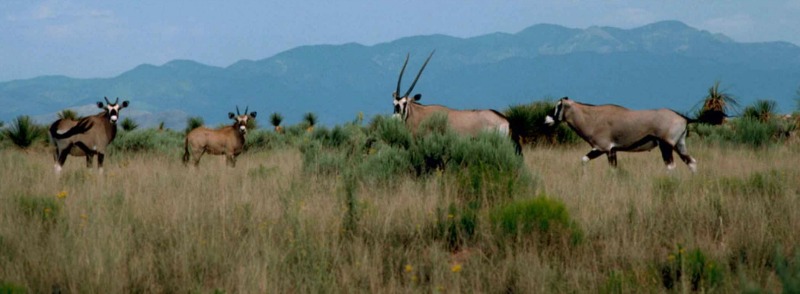 Gemsbok live in arid grasslands and rocky deserts
Gemsbok live in arid grasslands and rocky desertsGemsboks also engage in soil-eating, which allows them to obtain essential minerals lacking in their standard diet. Their most fascinating adaptation involves nocturnal grazing. Gemsboks graze extensively at night when cooler temperatures increase vegetation moisture levels, allowing them to extract more hydration from plant matter. This nocturnal feeding is crucial to the gemsbok's legendary ability to survive indefinitely without drinking water.
Additionally, gemsboks produce highly concentrated urine and allow their body temperature to rise instead of sweating, further conserving precious water reserves. This multi-faceted survival strategy makes them true desert specialists.
Social Structure and Herd Organization
Gemsboks display complex social hierarchies and herd structures. Small herds typically contain up to a dozen animals, though larger groups form in areas with reliable grazing. The species organizes into three primary group types: bachelor herds composed of young males, nursery herds containing only females and their calves, and mixed herds of all ages and sexes.
When food becomes scarce and unreliable, gemsboks wander widely in search of resources. Mature males are territorial but will temporarily join mixed herds containing adult females. This flexibility demonstrates their adaptive social behavior, allowing them to maximize survival chances in unpredictable desert environments.
Reproduction and Life Cycle
Gemsboks can mate at any time of the year, showing flexibility in reproductive timing. The territorial male's approach to finding breeding opportunities is distinctive. He tests a female's reproductive condition by sniffing her genitals and analyzing her urine for chemical signals indicating estrus. If he locates a female in heat, the bull approaches with his head held high or stretched forward, then taps her hind legs with his foreleg. If the female is receptive, she stands still while the male mounts her up to six times in quick succession.
The gemsbok's birth and early life strategy involves a unique hiding phase. For its first three to six weeks, the newborn calf typically remains concealed in dense grass while its mother grazes a distance away. The calf spends nights with its mother and finds a new hiding place each morning. This strategy protects vulnerable calves from predators. Remarkably, mothers occasionally must strike their calves with their horns to force them to hide—a counterintuitive but effective survival behavior.
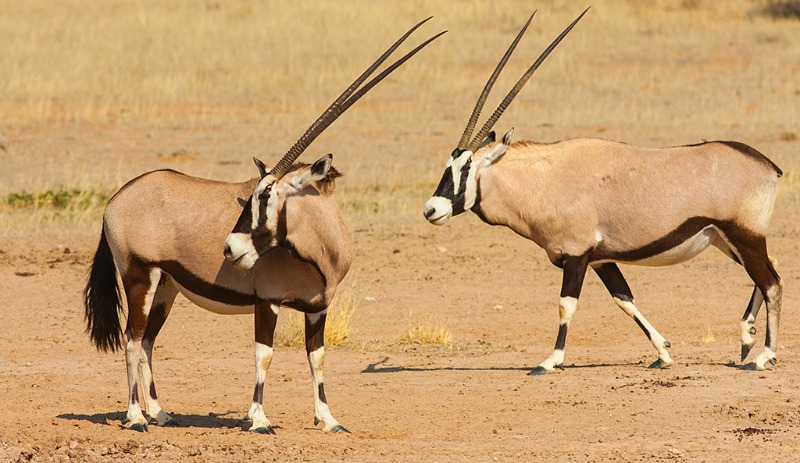 The stunning horns of Gemsboks, average 33 inches (84 cm) in length.
The stunning horns of Gemsboks, average 33 inches (84 cm) in length.Once the calf emerges from its hiding phase, it joins its mother with the rest of the herd and socializes in age-based groups called creches. Interestingly, calves' horns have already begun growing by the time they emerge, which has spawned the myth that gemsboks are born with horns. Calves are weaned at approximately six months of age, making them increasingly independent members of the herd.
Territorial Behavior and Male Dominance Displays
Territorial behavior in gemsboks is complex and multifaceted. Mature males establish and defend territories using several marking techniques. They thrash bushes vigorously with their horns, paw the ground dramatically, and create small, neat dung piles from a low crouching position to prevent pellets from scattering. Additionally, these antelopes possess glands between their hooves that mark the ground wherever they walk, leaving invisible chemical signals of territorial ownership.
Despite these marking behaviors, bulls cannot effectively protect their large territories from all intruders. Most intruders, however, voluntarily leave upon noticing a resident bull, resulting in relatively few violent confrontations. Territorial males generally accept younger males within mixed herds.
When conflicts do occur between males, they display highly ritualized behaviors before escalating to serious combat. Serious opponents circle each other slowly while pawing the ground and occasionally thrashing bushes with their horns. Only in the most severe encounters do bulls use their horns for actual jabbing attacks.
The unique angle and length of the gemsbok's horns prevent the typical fighting method of lowering the head and stabbing forward. Instead, deliberate fights involve a sophisticated technique: opponents stand alongside each other and hook their horns backward and sideways. The thick skin on a bull's neck and shoulders protects these battles.
His posture can easily identify the dominant gemsbok: head held high with a slightly bent neck, horns pointing toward his rival, and slow, steady, high steps while moving. The submissive animal displays a cringing posture with its head lowered and tail swishing nervously.
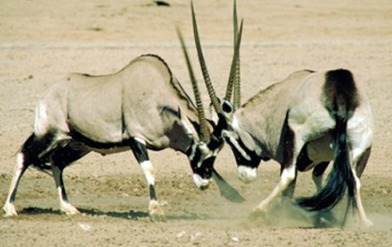
Predator Defense and Survival Mechanisms
The gemsbok possesses remarkable predator defense capabilities. Their horns are amazingly effective weapons against predators, even large carnivores. When facing multiple predators, gemsboks employ a sophisticated strategy: they back into a thorn bush to protect their rear while simultaneously slashing at attackers with their horns. This creates a nearly impenetrable defensive position.
Herds demonstrate collective defense behavior when spotted hyenas are detected, bunching tightly around calves to provide maximum protection. While accounts exist of eland (a different antelope species) impaling lions with their horns, gemsboks themselves represent important prey for larger carnivores despite their formidable defensive abilities.
The Science of Desert Survival: Thermoregulation and Rete Mirabile
The gemsbok's most remarkable adaptation to desert life involves a sophisticated physiological mechanism called rete mirabile (Latin for "wonderful net"). This specialized network of blood vessels allows gemsboks to maintain stable brain temperature despite extreme environmental heat.
The system works through an elegant process of heat exchange. Blood flowing to the brain is cooled by contact with blood flowing from the nasal membrane, which has been exposed to the cooler air during respiration. This process effectively cools the body's heat balance, allowing gemsboks to maintain normal brain function and cognitive ability even in extreme desert conditions exceeding 50°C (122°F).
What makes this adaptation even more remarkable is the gemsbok's apparent indifference to extreme daytime heat. Unlike most animals, gemsboks don't seem bothered by intense heat and not attempt to avoid it during the day. Combined with their nocturnal grazing habits, concentrated urine production, and heat-tolerant physiology, this mechanism enables gemsboks to thrive indefinitely in environments where most other large animals cannot survive.
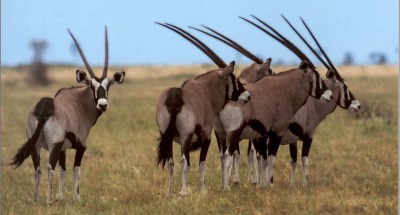 In the Kalahari Gemsbok make up 32% of lion kills and 52% of hyena kills
In the Kalahari Gemsbok make up 32% of lion kills and 52% of hyena killsHow to Spot a Gemsbok in the Wild
For wildlife enthusiasts and safari participants, identifying gemsboks in their natural habitat is relatively straightforward. Their striking black and white facial markings and distinctive long horns make them instantly recognizable. Look for these impressive antelopes in the arid grasslands and rocky deserts of southern Africa, particularly throughout the Kalahari region.
Gemsboks are most commonly observed during dawn and dusk hours when they're actively grazing. Their pale fawn-grey coloration provides excellent camouflage in desert landscapes, so look carefully along the horizon. During the harsh midday heat, gemsboks often rest in shaded areas, making early morning and late afternoon the optimal times for wildlife observation.
Conclusion: Nature's Desert Warrior
The gemsbok stands as one of nature's most perfectly adapted desert survivors. With their distinctive appearance, sophisticated behavioral strategies, and remarkable physiological adaptations, these African antelopes represent the epitome of evolutionary success in harsh environments. From their legendary ability to survive without drinking water to their ingenious use of thermoregulation, gemsboks demonstrate that survival often depends not on size or strength, but on intelligent adaptation to environmental challenges.
As Africa's arid ecosystems face increasing pressure from climate change and human activity, understanding and appreciating these remarkable animals becomes more important than ever. Whether encountered on a wildlife safari or studied through wildlife photography and documentaries, gemsboks continue to captivate observers with their silent majesty and inspiring resilience. These desert survivors remind us of nature's extraordinary capacity for innovation and adaptation in even the most extreme conditions.

